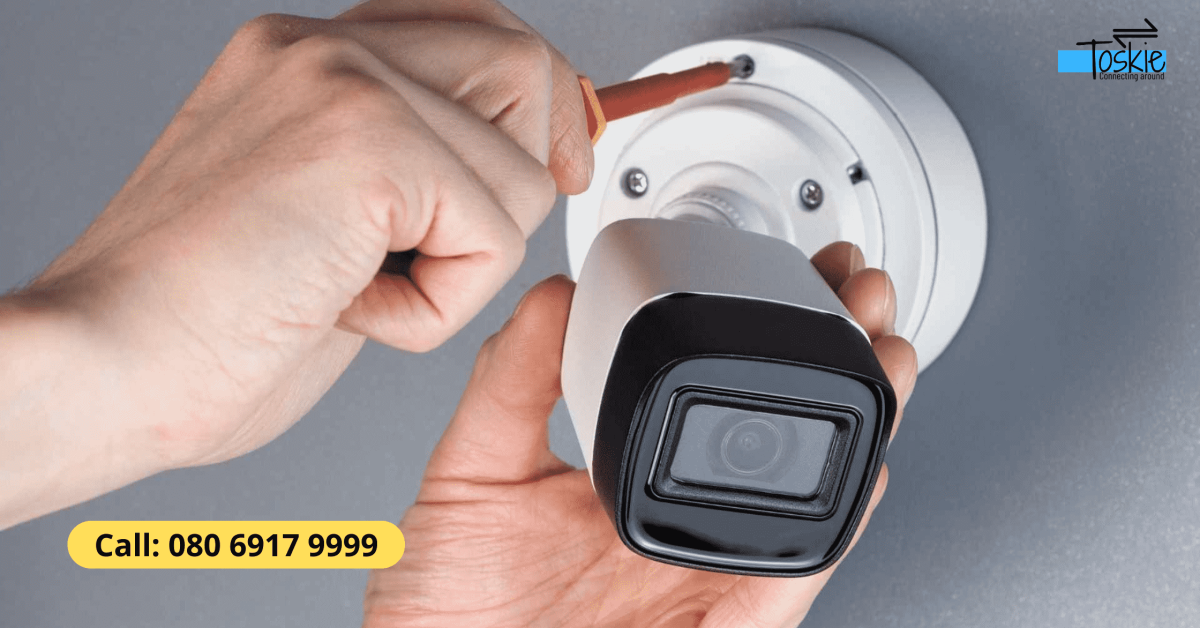In today’s world, securing your property with a reliable CCTV system is more important than ever. Whether you’re safeguarding your home or business, understanding the intricacies of CCTV camera installation services can help you make informed decisions and ensure maximum security. This comprehensive guide covers everything you need to know about security camera installation, from choosing the right type of camera to understanding video storage options.
Security Camera Installation: Where Do You Install Security Cameras?
The effectiveness of your CCTV system heavily depends on the strategic placement of your security cameras. Proper installation ensures that all vulnerable areas are covered, minimizing blind spots and maximizing surveillance coverage.
Outdoor Camera Placement:
For outdoor security, focus on key entry points like front and back doors, driveways, side entrances, and large windows. These areas are common targets for intruders and should be monitored closely. Placing cameras at these locations not only deters potential intruders but also provides valuable evidence in the event of a break-in.
Indoor camera placement:
Indoors, cameras should be positioned to monitor high-traffic areas and locations where valuable assets are stored, such as living rooms, hallways, and offices. Additionally, placing cameras near windows that could serve as potential entry points adds an extra layer of security. This setup ensures that any unauthorized movement within your property is recorded, providing a comprehensive view of your security landscape.
Camera angle and positioning
Achieving the right camera angle and positioning is crucial for capturing clear and useful footage. The goal is to cover the widest possible area while ensuring the camera captures detailed images, especially of faces.
Height and angle:
Cameras should be mounted high enough to avoid tampering but angled downward to capture clear images of anyone approaching. This downward angle is particularly effective in capturing facial details, which are essential for identification.
Field of View:
Ensure that the camera’s field of view is not obstructed by objects like trees, walls, or furniture. The positioning should allow the camera to monitor the intended area without any blind spots. For outdoor cameras, consider factors like weather conditions and potential sources of glare, such as direct sunlight, which can affect image quality.
Basic Components of a CCTV System
A CCTV system is more than just cameras; it includes several key components that work together to provide comprehensive surveillance coverage.
Cameras:
These are the core of your system, serving as the eyes that capture all activity. Cameras come in various types, each suited for different environments and purposes. For instance, bullet cameras are ideal for long-distance viewing, while dome cameras are better suited for discreet indoor monitoring.
Cabling and wiring:
Cabling is essential for connecting your cameras to the recording device. Traditional systems use coaxial cables, but modern installations often rely on IP Camera Installation Cabling, which allows for easier setup and higher-quality video transmission.
Network Video Recorder (NVR):
The NVR is where your footage is stored and managed. It allows you to access video recordings remotely, making it easier to monitor your property from anywhere. NVRs are generally preferred over DVRs because they are compatible with modern IP cameras and offer better video quality.
Hard Drives:
These are crucial for storing recorded footage, especially if you prefer local storage. The size of the hard drive will determine how much footage you can store before it’s overwritten. Larger systems with multiple high-resolution cameras will require more storage capacity.
Which is better, DVR or NVR?
Choosing between a DVR (Digital Video Recorder) and an NVR (Network Video Recorder) is a significant decision that impacts the functionality and scalability of your CCTV system.
DVR Systems
DVRs are more traditional and typically used with analog cameras. They are more affordable but come with limitations, such as lower video quality and more complex wiring requirements. DVRs require coaxial cables, which can be cumbersome to install, especially in large properties.
NVR Systems:
NVRs are more advanced and are designed to work with IP cameras, which offer higher video quality and more flexibility. IP cameras can connect to the NVR via a network, reducing the need for extensive wiring. NVR systems are generally easier to install and better suited for modern surveillance needs. For most users, especially those setting up a new system, an NVR is the better choice due to its superior performance and ease of use.
Security Camera System Installation: Video Storage
Once your cameras are set up, the next critical consideration is how to store the footage they capture. Video storage is a vital component of your CCTV system, as it determines how long you can keep recordings and how easily you can access them when needed.
How much storage do you need?
The amount of storage you require depends on several factors, including the number of cameras, the resolution of the footage, and how long you want to keep the recordings. For example, a system with multiple high-resolution cameras will need significantly more storage than one with fewer, lower-resolution cameras. Additionally, if you need to retain footage for extended periods (for legal reasons), you’ll need a larger storage capacity.
Do You Need a Hard Drive for Security Cameras?
Yes, most CCTV systems require a hard drive to store recorded footage. This is especially true for NVR and DVR systems. Hard drives are reliable and provide quick access to past recordings. However, they have limited storage, so you may need to delete or back up older footage regularly to make room for new recordings.
What about cloud storage?
Cloud storage is an increasingly popular option for CCTV systems. It offers several advantages, including remote access to footage, automatic backups, and the ability to store large amounts of data without the need for physical hard drives. Cloud storage also provides added security since your footage is stored off-site, protecting it from theft or damage. However, cloud storage usually comes with a subscription fee, and the cost can increase based on the amount of storage you require.
Types of security cameras
Security cameras come in various shapes and sizes, each designed for specific use cases. Understanding the different types will help you choose the right camera for your needs.
Bullet Cameras:
These cameras are long and cylindrical, making them easy to spot. They are ideal for outdoor use, particularly for monitoring long distances like driveways or perimeters. Bullet cameras are typically weatherproof and have a narrow field of view, making them perfect for focused surveillance.
Dome Cameras:
Dome cameras are named for their dome-shaped casing, which makes them less noticeable and harder to tamper with. They are often used indoors in places like retail stores or offices. Their wide-angle lenses allow them to cover a larger area, making them suitable for monitoring rooms and hallways.
Turret Cameras:
Turret cameras are versatile and often feature infrared LEDs for excellent night vision. They are like dome cameras but without the protective casing, making them easier to adjust. Turret cameras are ideal for both indoor and outdoor use.
PTZ (Pan Tilt Zoom) Cameras:
PTZ cameras can be remotely controlled to pan, tilt, and zoom, covering large areas and focusing on specific details when needed. They are commonly used in large spaces like parking lots or stadiums, where extensive coverage is required.
Fisheye Cameras:
These cameras offer a 360-degree view, making them ideal for monitoring wide-open areas. Fisheye cameras can cover an entire room with a single device, reducing the need for multiple cameras.
Multiple Sensor Cameras:
Multiple sensor cameras have multiple lenses, each covering a different angle. This allows them to monitor a wide area with a single device, making them ideal for large, open spaces.
Doorbell Cameras:
Doorbell cameras are small, discreet cameras that replace your traditional doorbell. They allow you to see and communicate with visitors at your door via your smartphone, even when you’re not at home.
Wireless Cameras:
Wireless cameras offer flexibility in installation since they don’t require cabling. They are ideal for areas where running wires are difficult or impossible. Wireless cameras can be used both indoors and outdoors, but they may require regular battery changes or recharging.
Indoor or outdoor business security cameras
When selecting security cameras for your business, you’ll need to decide whether they will be used indoors, outdoors, or both. Each environment presents unique challenges that must be addressed to ensure optimal performance.
Do outdoor cameras need to be weatherproof?
Yes, outdoor cameras must be weatherproof to withstand elements like rain, snow, and extreme temperatures. Look for cameras with an IP66 or higher rating, which indicates that they are protected against dust and water. Weatherproof cameras are also more durable and can withstand physical impacts better than standard cameras.
Should I hide my outdoor security cameras?
Visible security cameras can act as a powerful deterrent to potential intruders, as their presence alone can make criminals think twice. However, there are scenarios where hidden cameras might be more effective, such as in areas where you suspect ongoing theft or vandalism and want to catch the perpetrator in the act.
Can You Use an Outdoor Security Camera Indoors?
While outdoor cameras can be used indoors, they are often bulkier and more rugged than necessary for indoor use. Additionally, outdoor cameras are designed to withstand the elements, which isn’t typically required indoors. However, if you need a high-powered camera with a wide field of view, an outdoor camera might be a good choice for indoor use.
Do security cameras work in the dark?
Yes, many modern security cameras are equipped with night vision or infrared (IR) capabilities, allowing them to capture clear footage even in complete darkness. IR cameras use infrared light to illuminate the area in front of them without being visible to the human eye. This makes them ideal for monitoring properties at night or in low-light conditions.
Conclusion
Installing a CCTV system is a key step in protecting your property. Understanding the various components, installation methods, and camera types helps you build a strong security system. If you need professional help, expert CCTV installation services can ensure your system is properly set up and meets your specific needs. Toskie makes it easy to find the best-rated CCTV installation services, so you can get top-quality security for your property.
CCTV Camera Installation Services
Toskie connects you with top-rated CCTV camera installation services for your home or business. For expert help, call 080 6917 9999 today and ensure your property is well-protected.
Book Now
